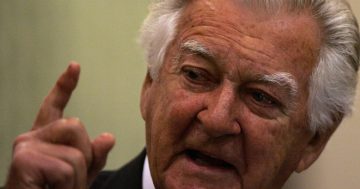
Is Laissez-faire economics just lazy and unfair?
It seems, at the moment, that laissez-faire economics is in the background and not front and centre as we saw during much of the Howard government era.
But, have no doubt, it is like a new strain of COVID – it lurks ever in the shadows, waiting to re-emerge and make life hard for all.
Laissez-faire economics is also known as ‘trickle-down’ economics, neo-liberalism, Reaganomics and anarcho-capitalism, among other names.
I prefer to call it Lazy Economics.
It basically supports minimal or zero government intervention in the market on the basis that the market will automatically operate in a manner that is fair and equitable.
By default, it allows the biggest, most powerful businesses and unions to thrive at the expense of small and family enterprises.
It also often results in higher prices, decreased innovation and the most vulnerable of our society being left behind.
It is often seen as a Liberal Party mantra, as opposed to Labor or the Nationals, who tend to support government intervention.
Yet those that support lazy economics also include most big unions.
Unions have few members in small business, so their preference is for the survival of the biggest businesses as this maximises their leverage against employers.
The retail union has most of its members in Coles and Woolworths; the transport workers union has most of its members in the road transport sector; and the CFMEU has most of its members in large mines and some of the biggest construction companies in Australia.
It is in their interest to support most big businesses who employ and demonise those that use outsourcing and labour hire models.
Lazy economics is not necessarily part of the history of the Liberal Party.
In fact, Robert Menzies, that party’s founder, actually condemned laissez-faire economics in his famous ‘Forgotten People’ speech of 1943. As well as condemning fascism, communism and socialism, Menzies stated, “Individual enterprise must drive us forward”.
That does not mean we are to return to the old and selfish notions of laissez-faire.
The functions of the state will be much more than merely keeping the ring within which the competitors will fight.
When Graeme Samuel was chairman of the ACCC, he once told a small business group that under the Howard-Costello government, competition existed even if there were only two businesses in a particular market.
As one result, we see a ‘two airline policy’ that cedes unreasonable market power to Qantas which, coupled with deft lobbying, means that they get to decide which other airlines are allowed to fly into Australia.
The lack of genuine competition within the Australian airspace has made it difficult for new competitors to succeed, resulting in high ticket prices and plenty of cancelled flights.
But Samuel was replaced by Rod Sims. Sims demonstrated his belief in the science of economics and quality competition policy, as first espoused by Adam Smith in 1776 in his treatise The Wealth of Nations.
During Rod’s time, we saw improved competition in key markets. We were allowed to talk about reality rather than being hushed by the loud advocacy of big Australia.
We were able to highlight that a sustainable economy required innovation, choice, diversity and markets comprising many big and small enterprises.
True competition and economic rationalism is the correct approach. It is not about protectionism; it is about managing an economy and managing the effects of change as our globally connected world is constantly reshaped by technological innovation.
Economic rationalists also demonstrate compassion. Lazy economists demonstrate complete indifference about negative impacts on real people.
I once had a state chamber of commerce CEO tell me, “The best thing about small business is that when one falls over, another takes its place”.
A telling sign that lazy economists care naught for small and family business people – and their employees. Laissez-faire economists will aggressively and belligerently yell, “Let the market decide”.
Then they close their eyes and dream of a world with two businesses, one government, one economist and no public service — their nirvana.
Economic rationalists will quietly state, “We must make sure the market can decide”. The nuance in the position of rationalists is that they believe meaningful and efficient actions of government are required to maintain competition and choice for consumers.
So, what are some examples of good economic rationalism?
The management of industry restructuring led by John Button during the Hawke/Keating years and the introduction of the goods and services tax by John Howard and Peter Costello are two great examples. Both decisions were monumental.
These actions changed the Australian economy and our budgetary processes forever.
But they were not pain-free.
In the first instance, businesses closed their doors and people lost their jobs. In the second instance, all businesses were required to institute massive change.
Both processes needed deep and constant communication for success – and this was provided. Affected parties were engaged in developing solutions and allocating funds to assist in the transition.
That’s how you become a practising economic rationalist – by management, not indifference. It basically comes down to taking others with you through change.
Is our future one of lazy economics and disgruntled voters? Or one that embraces economic rationalism with transparency, engagement and commonsense?
With the minister responsible for Competition Policy, Canberra’s own Andrew Leigh, on the job, we should be able to keep the lazy economists away – but can he resist the attacks that will come from the biggest unions?
Original Article published by Peter Strong on Riotact.








